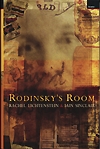RODINSKY'S ROOM
The room: An empty
apartment, untenanted for over a decade until opened
in the early eighties, everything in it waiting beneath a layer of
dust, as if the owner has stepped out to the corner store and
evaporated on his way back.

Tucked inside books are notes written in ancient scripts, dictionaries of dead languages lay stacked in towers upon the floor, a whole notebook is filled with irish drinking songs, and beneath a wardrobe lies a crumpled, cabalistic diagram, the set prop of the vanished jew. David Rodinsky lived (so it appears) in this small apartment above a synagogue in London's East End. Beyond that, almost anything said about him is conjecture and hearsay, leading Rachel Lichtenstein and Iain Sinclair into Whitechapel's baroque underworld. The two couldn't be better suited to the job, Lichtenstein a young artist getting a grasp on her identity by interpreting her place in the Jewish world through her photographs and studies, Sinclair, a poet and London essayist obsessed with forgotten histories, obscure neighborhoods, and human wrecks. Others had seen the room and written Rodinsky off as nothing but a crank; Sinclair had even warned Lichtenstein that the room was a trap. Still, she tracks down relatives and writes movingly of her meetings with frail, elderly immigrants. She can't reconstruct the Jewish East End, but offers glimpses of the life her grandparents led there in their watch shop, trying to find a context for Rodinsky, to understand what his language studies meant, whether he was the autistic child of a traumatized mother, or one of the 36 lamed vavniks whose task, working in secrecy and without reward, is to keep the world from being destroyed. Sinclair imagines Rodinsky as a Golem constructed by those who view the room, his figure activated in their minds as the protector of a Jewish community long since vanished from the East End. He'd rather not sentimentalize the past, or feed into myths of the wandering jew. There are many odd turns here and before the end Lichtenstein finds herself identifying with Rodinsky's contrary characteristics--his fascination with his ancestor's history, his wish to free himself from his estrictive community, his fanatical cataloguing of scraps, his abandonment of all his work. Unlike many biographers who come to know their subjects so well they loathe them, for Lichtenstein and Sinclair Rodinsky remains tantalizingly beyond reach, there aren't even any photographs of him, just one of his sister which stands in for them both.
It becomes a fine image for the mystery he retains; in that crowded past, Rodinsky always disappears behind another face.

Tucked inside books are notes written in ancient scripts, dictionaries of dead languages lay stacked in towers upon the floor, a whole notebook is filled with irish drinking songs, and beneath a wardrobe lies a crumpled, cabalistic diagram, the set prop of the vanished jew. David Rodinsky lived (so it appears) in this small apartment above a synagogue in London's East End. Beyond that, almost anything said about him is conjecture and hearsay, leading Rachel Lichtenstein and Iain Sinclair into Whitechapel's baroque underworld. The two couldn't be better suited to the job, Lichtenstein a young artist getting a grasp on her identity by interpreting her place in the Jewish world through her photographs and studies, Sinclair, a poet and London essayist obsessed with forgotten histories, obscure neighborhoods, and human wrecks. Others had seen the room and written Rodinsky off as nothing but a crank; Sinclair had even warned Lichtenstein that the room was a trap. Still, she tracks down relatives and writes movingly of her meetings with frail, elderly immigrants. She can't reconstruct the Jewish East End, but offers glimpses of the life her grandparents led there in their watch shop, trying to find a context for Rodinsky, to understand what his language studies meant, whether he was the autistic child of a traumatized mother, or one of the 36 lamed vavniks whose task, working in secrecy and without reward, is to keep the world from being destroyed. Sinclair imagines Rodinsky as a Golem constructed by those who view the room, his figure activated in their minds as the protector of a Jewish community long since vanished from the East End. He'd rather not sentimentalize the past, or feed into myths of the wandering jew. There are many odd turns here and before the end Lichtenstein finds herself identifying with Rodinsky's contrary characteristics--his fascination with his ancestor's history, his wish to free himself from his estrictive community, his fanatical cataloguing of scraps, his abandonment of all his work. Unlike many biographers who come to know their subjects so well they loathe them, for Lichtenstein and Sinclair Rodinsky remains tantalizingly beyond reach, there aren't even any photographs of him, just one of his sister which stands in for them both.
It becomes a fine image for the mystery he retains; in that crowded past, Rodinsky always disappears behind another face.



